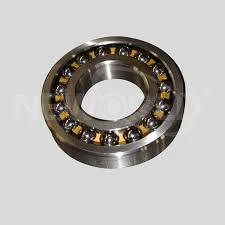
Okt . 21, 2024 10:49 Back to list
Thrust Ball Bearing Selection Guide and Specifications for Optimal Performance
Understanding Thrust Ball Bearings A Comprehensive Overview
Thrust ball bearings are critical components in various mechanical applications, where they are primarily used to support axial loads and enable smooth rotational motion. These bearings are specifically designed to handle thrust, a type of load that acts parallel to the shaft, as opposed to radial loads that work perpendicular to it. In this article, we will explore the design, functionality, applications, and maintenance of thrust ball bearings, which are essential for ensuring the longevity and efficiency of machinery.
Design and Structure
A thrust ball bearing typically consists of three main components the balls, the shaft washer, and the housing washer. The balls, usually made of chrome steel or stainless steel, are positioned between the two washers. The shaft washer is mounted on the shaft, while the housing washer is fixed to the stationary part of the machinery. This assembly allows for smooth movement and minimal friction when the shaft rotates. The design can be further categorized into single direction and double direction thrust ball bearings.
Single direction thrust ball bearings can support axial loads in one direction only, while double direction thrust ball bearings can sustain axial forces from both sides. This distinction is crucial in applications where load direction can change or where reverse functionality is required.
Functionality
Thrust ball bearings operate on a simple principle the balls roll between the two washers, allowing for smooth rotation and effective load support. This design minimizes drag and friction, which is essential for high-speed applications. The load-carrying capacity of the bearing is determined by several factors including the size of the balls, the material used, and the precision of the manufacturing process. High-quality thrust ball bearings can perform efficiently even under substantial loads while providing durability and longevity.
Proper lubrication is vital for thrust ball bearings. Grease or oil reduces friction and wear, helping to maintain optimal performance. The right type of lubricant is determined by the operating conditions, including temperature, speed, and load. Regular maintenance checks, including lubrication and visual inspections, are essential to prevent premature wear and ensure the bearing operates effectively.
Applications
Thrust ball bearings are widely used in various industries due to their ability to handle axial loads efficiently. Common applications include
thrust ball bearing catalog

1. Automotive Industry Thrust ball bearings are utilized in clutches, gearboxes, and wheel hubs, where they support axial loads and allow for smooth operation. 2. Aerospace In aircraft engines, thrust ball bearings are crucial for facilitating smooth rotational motion and enhancing performance under extreme conditions.
4. Home Appliances Thrust ball bearings are also found in various household devices, such as washing machines and electric fans, where they ensure reliable operation.
Maintenance and Care
To prolong the lifespan of thrust ball bearings, regular maintenance is essential. Users should consider the following practices
- Regular Lubrication Ensure that the bearings are adequately lubricated based on the manufacturer's recommendations. This helps minimize wear and tear. - Check for Wear Periodically inspect the bearings for signs of wear or damage, such as pitting, discoloration, or excessive noise during operation.
- Load Monitoring Be mindful of the operational loads. Overloading a thrust ball bearing can lead to premature failure, so it’s important to ensure that the loads are within the specified limits.
- Environment Control Keep bearings in clean environments and shield them from contaminants such as dust and moisture, which can compromise their performance.
Conclusion
Thrust ball bearings play a pivotal role in modern machinery and equipment by providing support for axial loads and enabling smooth rotational motion. Their simple yet effective design, combined with proper maintenance, allows them to withstand diverse operating conditions. By understanding their functionality, applications, and care, users can maximize the efficiency and longevity of thrust ball bearings in various settings. Whether in automotive, aerospace, or industrial applications, these bearings are fundamental to the performance and reliability of machinery.
Latest news
-
Spherical Roller Bearings Applications: Heavy Duty, Self-Aligning
NewsAug.30,2025
-
Premium Deep Groove Ball Bearings | High Speed & Reliability
NewsAug.29,2025
-
Durable Scaffolding Clamps - Secure & Reliable Tube Connectors
NewsAug.28,2025
-
Common Failures in Thrust Ball Bearings and Solutions
NewsAug.22,2025
-
How Tapered Roller Bearings Can Take Shock Loads
NewsAug.22,2025
-
Angular Bearings in High-Precision Spindles
NewsAug.22,2025
